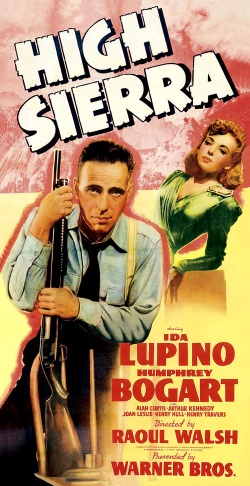
HIGH SIERRA
US, 1941, 100 minutes, Black and white.
Humphrey Bogart, Ida Lupino, Joan Leslie, Cornel Wilde, Alan Curtis, Arthur Kennedy, Henry Travers.
Directed by Raoul Walsh.
High Sierra was a fine thriller of the forties featuring Humphrey Bogart in one of his best gangster roles. It marked his emergence from supporting roles or co-stardom to main-featuring. Bogart is excellent as the criminal on the run who is befriended by the crippled girl, played by Joan Leslie. The film is both tough and tender at the same time. A young Cornel Wilde can be seen in a gangster role.
The film was remade in western form as Colorado Territory in 1949 with Joel Mc Crea and Virginia Mayo. The original was directed by Raoul Walsh, a noted director at Warner Bros. in the forties, especially for his action dramas. Stuart Heisler directed another remake in 1955 called I Died a Thousand Times. In this film Jack Palance takes the Humphrey Bogart role and invests it with Palance's sinister style. Shelley Winters takes the Ida Lupino role. Lori Nelson has the Joan Leslie role. Lee Marvin was also featured as a gangster. The latter film, following the original fairly closely, was filmed in Cinemascope and colour and has a spectacular atmosphere about it, compared with the grittiness of the original. However the plot and the characterisations in all versions are very strong and make it effective gangster material.
1. How good a thriller? Its use of thriller conventions? Above average use or not?
2. How typical a film of the thirties and forties?
3. How typical a Bogart vehicle? The impact of Humphrey Bogart and his style? What attracts audiences to Bogart films?
4. Comment on the quality of production, black and white photography, techniques, the use of newspapers, the picture of the police? The use of location photography?
5. The impact of the gangsters on the screen? Comment on the closeness of this film to the real gangsters of the 30s, how authentic did the film seem?
6. What kind of man was Roy Earl? The presentation of him an a killer? Wanting to do a lost job? Yet the homely side of Earl? Bogart style and interpretation? The cold blooded planning of the robbery, the killings? Yet sympathy for people, for Marie, for Velma, and for Pa, even for the dog? How was the criminal mind illustrated by this characterisation? An American criminal and American movie styles? How much sympathy for Roy? how much insight into him? Audience response to his death?
7. The planning and staging of the robbery?
8. How important was the sub-plot with Velma? How well integrated was Velma into the plot? Earl’s relationship with Pa? Velma as a person, the depression background? Pa and Velma moving? Velma’s last chance for health, for love? The impact of the good done? Roy’s disappointment in the way that she turned out? Audience response to the final look at Velma?
9. How did Marie contrast with Velma? Sticking to Roy? the participation in the robbery, support of Roy and flirting with him? The importance of her meeting Velma? Her support of Roy at the end, at his death? Was any insight given into the character of this kind of women?
10. Red and Babe as 30s and 40s criminals? what motivated them? What types of personalities, styles? The suddenness of their deaths?
11. The portrayal and character of Mandoca? The petty criminal, the killing?
12. Mac as a criminal? His dying sequences? The relationship with Roy? The humanity?
13. How interesting was the portrayal of America in the 30s? The Depression, criminals and gangsters, popular opinion? Roy and his visit to his home in Indiana? The contrast of the desert and Los Angeles? The Sierras as a refuge and a place to disappear?
14. How do gangster films illustrate human values?